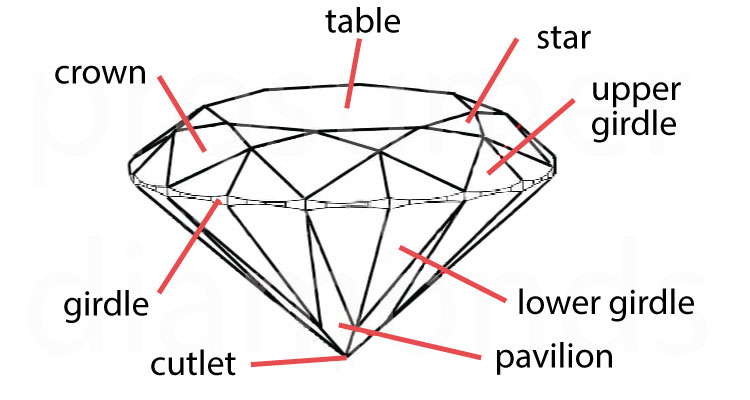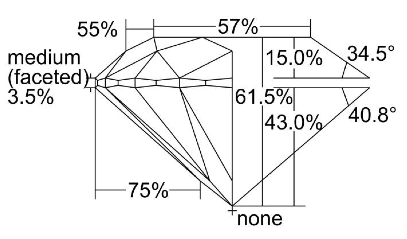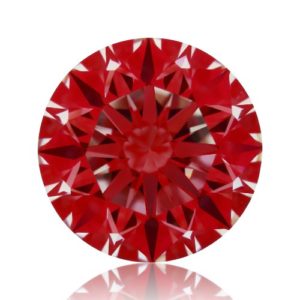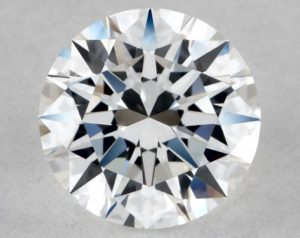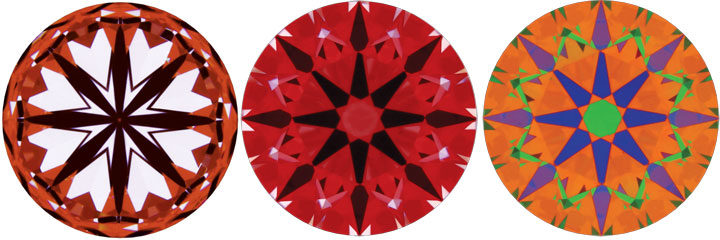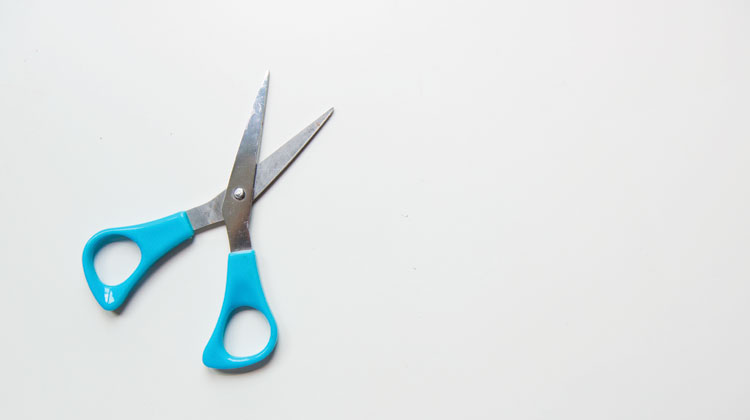
Gemstone cutters have always known that the faceting on a diamond is what gives it ‘life’. Even before there were grading certificates, traders would factor cut quality into the price of diamonds. It’s now universally accepted that cut is the most important factor out of the 4Cs of diamonds so you better pay attention.
This tutorial is designed to get you familiarized with some of the cut terminology that you’ll come across in the early stages of your diamond search.
Diamond Proportions
A modern round brilliant has 57 facets plus a girdle and a culet.
Reading a Proportions Diagram
- There’s the table percentage (57%) and the total depth (61.5%)
- 8 crown facets are measured by the crown height (15.0%) and angle (34.5°).
- 8 pavilion facets are measured by the pavilion depth (43.0%) and angle (40.8°).
- 8 star facets are referred to by the star length (55%) and is measured by how far a star facet extends toward the girdle edge.
- 16 lower girdle facets are measured by the lower girdle length (75%), which is how far a lower girdle extends toward the culet.
- 16 upper girdles are not given a measurement on a lab report.
- The girdle thickness is given a description (medium) and percentage (3.5%) that is measured from the thinest to thickest parts of the girdle’s ‘valley’ positions (thin-parts).
Notes:
All % are measured as as percentage of the diamond’s diameter.
All angles are measured from the plane of the girdle.
A longer star length implies steeper star and upper girdle angles.
A longer lower girdle length implies a shallower lower girdle angle.
All of the proportions are rounded and averaged results.
The total depth does not always equal the sum of the crown height, girdle thickness, and pavilion depth because the total depth would factor in the thickness of the girdle at the hills and not the valley positions.
A GIA “Very Good” cut is not really very good at all
The Gemological Institute of America (GIA) divides cut into 5 cut grades:
- Excellent
- Very Good
- Good
- Fair
- Poor
The American Gem Society (AGS) adopts a numbering system that goes from 0-10, which can be divided into six categories:
- Ideal = 0
- Excellent = 1
- Very Good = 2
- Good = 3 to 4
- Fair = 5 to 7
- Poor = 8 to 10
The AGS system is based on light performance and is much more advanced than the proportions based system GIA still uses. The AGS Ideal cut grade is considered much stricter in terms of grading cut than a GIA Excellent and the proportions that satisfy a GIA Excellent cut can fall anywhere between an AGS 0-2 in light performance.
Despite all these different cut grades issued by the labs, in practice you really only need to focus on GIA Excellent or AGS 0 cut diamonds. Many people don’t understand how this can be until they realize that GIA has to balance the interest of many people in the diamond industry. For most people, a GIA Excellent cut should be your minimum starting point.
This means you should avoid the very good cut grade because the truth is diamonds that receive only a very good cut grade are usually not very good at all. If you’re just starting your diamond search, then you will quickly realize that even a GIA Excellent/AGS 0 cut grade is not a guarantee that a diamond is cut to the highest standard possible. For more information on the labs, you can read my articles on the Gemological Institute of America and the American Gem Society.
Symmetry and Polish
Related to cut is the finish quality of the diamond, which is graded on symmetry and polish. Both refer to the level of craftsmanship in producing the diamond and are graded on the same scale as cut.
When a diamond is graded Excellent or Ideal in cut, symmetry, and polish, then it is referred to as a “GIA Triple Excellent” or “AGS Triple Ideal“. The AGS Triple Ideal is commonly misrepresented as an “AGS Triple Zero” (AGS000), which strictly speaking only refers to a diamond that is AGS0 in cut, color, and clarity.
Avoid diamonds that come with lab reports which are more than a couple years old because the diamond may have been pre-owned and the polish of the diamond, which affects its luster, may no longer be the same. This is why I generally do not recommend diamonds that have older certificates unless you have it checked out by a professional appraiser or diamond expert.
Often when a diamond is re-sold, it will need to be re-polished and have a new certificate issued. There is a risk to getting a diamond re-graded because there is no guarantee that the same grade will be awarded. Re-polishing is how diamonds are recycled so even if a diamond has a recent certificate, it may still have been pre-owned and you will never know.
If you own a diamond and the lab report was issued before 1 June 2005 by the AGS Laboratory (AGSL) or issued before 1 January 2006 by GIA, these certificates are outdated and you should have the labs recheck the diamond.
The Ideal-cut
The ideal-cut is a misnomer because the term ideal gives the impression that it is perfect. If only buying a perfectly cut diamond was this simple! In the past, ideal-cut only referred to a diamond that is an AGS0 in cut. Today, the term ideal-cut is frequently misused to refer to GIA Triple Excellent diamonds as well.
Shallow and Steep-deep Diamonds
Shallow and steep-deep diamonds typically refer to poor combinations of crown and pavilion angles that either leads to a loss in fire and sparkle in the case of shallow diamonds, or a loss in brightness in the case of steep-deep diamonds. Unfortunately, many so called ideal-cut diamonds are either too shallow or steep-deep. Steep-deep diamonds are known for having a ring of light leakage under the table facet known as a ‘ring of death’.
The 60/60 Diamond
A 60/60 diamond refers to a diamond with a 60% table and a 60% total depth. This term was adopted because the trade used to believe that you could find the best performing diamonds simply using these two proportions. These diamonds are no longer considered the best cut, although some people still seek them out for their spread, which refers to how big a diamond looks for its carat weight.
A 60/60 diamond typically has a large circle in the middle of the diamond that is a reflection of the table facet and is called a “table reflection”. Sometimes you also get large hotspots (triangular black areas between the arrows), which makes the light leakage under the table facet less noticeable. The table reflection, hotspots, and light leakage are not areas of bright light return so the diamond is typically less bright than a Tolkowsky Ideal-cut.
Tolkowsky Ideal-cut
The Tolkowsky Ideal-cut (TIC) is named after Marcel Tolkowsky, a mathematician who famously published the proportions making up the perfect diamond in his thesis titled “Diamond Design, A Study of the Reflection and Refraction of Light in a Diamond” (1919).
Tolkowsky published a unique set of proportions:
- Table Percentage = 53%
- Pavilion Depth = 43.1%
- Pavilion Angle = 40.75 degrees
- Crown Height = 16.2%
- Crown Angle = 34.5 degrees
The TIC evolved to become the American Ideal-cut, which changed the ideal crown height to 14.6%. In 1969, the Scandinavian Standard-cut was published which was based on the American Ideal-cut with the ideal table percentage changed to 57.5%. The Scandinavian Standard-cut is in my opinion the set of proportions that produces the perfect balance between light performance and spread.
Today, the term TIC is used to refer to the range of proportions that surround the exact Tolkowsky numbers. This is because further research based on Tolkowsky’s work showed that there is actually a range of combinations, not only a single set of proportions, that produces diamonds with ideal light performance. Do not confuse the Tolkowsky Ideal-cut with the Tolkowsky brand of diamonds which are not all TIC diamonds.
Super Ideal-cut
The super ideal-cut is a combination of the TIC range of proportions and perfect optical symmetry representing the pinnacle of diamond cutting. A super-ideal diamond will display perfect hearts and arrows and have the best light performance. Super-ideal cut diamonds do not happen by luck, and cutting them requires careful planning from the rough stage and only the best rough diamonds can be cut into super-ideal cut diamonds.
This means that if you’re looking to purchase a super ideal-cut diamond be prepared to pay 10-20% more for a super ideal-cut. But be careful, not all branded diamonds or those that are marketed as hearts and arrows diamonds are true super ideal-cut diamonds.
